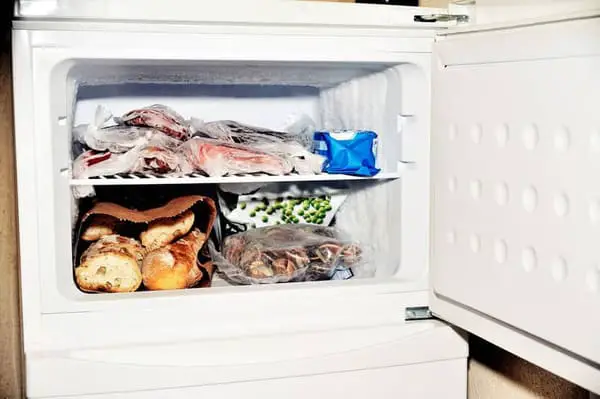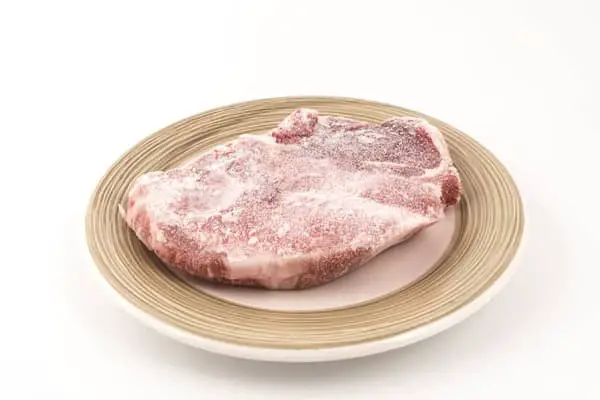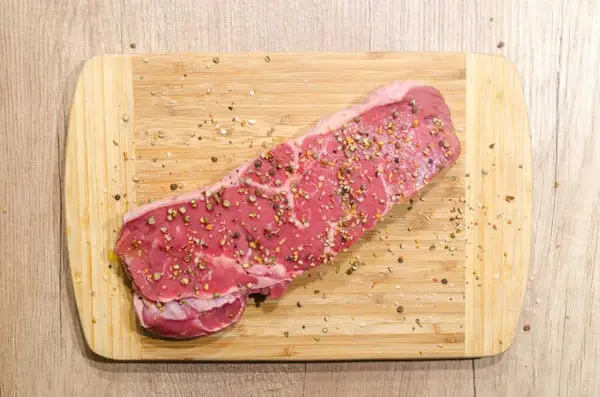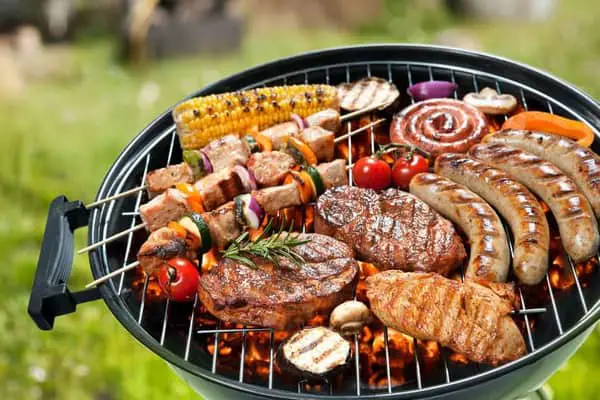
The grill might be all set up until you realize you forgot to defrost the meat. You may start wondering whether you can throw a solid piece of frozen meat on the grill and get the exact results. The truth will surprise you.
Can You Grill Frozen Meat?
Yes, you can, and in fact, it might turn out to be the best steak you have ever prepared. You read that right, it’s not only possible but also recommended. The only downside is that it will take 50% more time to get done.
This technique has been shown by experts to give superior results to grilling thawed meat. That’s because it solves the common problem of having the grey interior ‘banding’ by the time your steak gets a nicely charred crust. When you grill frozen meat, you get a uniformly pink interior with minimal gray banding under the surface, if any.
It’s a simple way to get a more tender and juicier steak.
But How Does it Work?
The frozen meat’s temperature protects the interior from overcooking as the interior temperature rises more slowly during grilling. You will, therefore, end up with a uniformly pink interior as the steak exterior chars.
On average, your meat will be ready in 30 to 40 minutes. However, the exact time it will take depends on several factors, including your grill type. Nevertheless, it will not take too long before its ready. You can get to enjoy an incredible meal within the hour.
In case you are wondering what kinds of meats can be grilled frozen, then you will be glad to know it’s all kinds of meats. It doesn’t matter what you have stored in your freezer. For steaks, porterhouse, ribeye, pork chops, and T-bone are great choices. Chicken, turkey, lamb or any other meat will also taste great when directly grilled. If done right, your family and friends will get to enjoy a delicacy like no other.
Safety is always a major concern when it comes to unconventional techniques. However, rest assured that grilling meat without thawing it is safe. As long as the meat has been frozen correctly, there is no need to worry.
But There’s More
You want to try out the grilling. Below is the step by step process of grilling frozen meat. Additionally, there are tips and tricks to help you get the best results. But before we dive into the details, let’s start with why you are here.
Why Grill Frozen Meat
There are mainly two reasons why you may end up grilling frozen meat. And that’s where the advantage lies with this technique, unlike the others.
Save Time
Grilling frozen meat directly saves you time. Most people discover that this method works great when they try it out at that moment they have no other alternative. It’s the perfect option when:
- In a rush without a plan
- You receive unexpected guests
- You want to give your kids a quick treat
The technique can be a real savior. You can then easily turn an unplanned dinner into a memorable one. Simply get from work and start grilling to give your family a tasty treat. You don’t have to start thinking about ordering pizza when your freezer is full of frozen meat that can be directly grilled.
Quality
Grilling frozen meat directly results in perfection from edge to edge. It’s an easy way to get a uniformly pink interior in a grilled steak. The low temperatures offer thermal protection to the interior, which will allow it to retain moisture and therefore taste great.
You don’t have to deal with the grey bands formed when the meat proteins hit 140ºF. At this temperature, the protein fibers begin to undergo three changes:
- Shrinking and tightening
- Squeezing out their water and drying
- Development of grey bands
Keeping the interior temperatures lower will protect the protein fibers and result in better quality meat when grilled.
How to Grill Frozen Meat
The ingredients needed are 1 to 1-1/2″ frozen steaks, kosher salt, and pepper. Kosher salt is great for this technique because it adheres more readily to food than granulated table salt.

1. Get the Right Frozen Meat
You will get good results when the meat is frozen right. When freezing the meat, place it on a flat surface, for instance, a sheet pan before you put it into your freezer. If the meat is flat, the frozen sides have more direct contact with the grill grate, which allows for a better sear.
You can use parchment paper to line the sheet pans, which keeps the steaks from adhering. Additionally, leave the steaks uncovered until fully frozen, which will keep it drier by allowing the moisture on the surface to evaporate. Doing so allows the steaks to sear better. Transfer them to zipper seal bags when intending to store for the long term.
Don’t let the steak stay for too long in your freezer. In about three to six months, your steak starts to get freezer burn.
You can also buy frozen meat and grill it directly. Ensure you opt for the perfectly flat steaks.
2. Fire Up Your Grill
Prepare your two-zone fire setup grill and bring it up to heat. If it’s a charcoal grill, allow it about 10 to 15 minutes for it to get to the right temperature. For a gas grill, 5 minutes are adequate to get it high enough for the searing of your steaks.
Next up is to brush the grill grates clean. You will now be all set to work some magic. Get your timer and instant-read thermometer and get grilling.
3. Sear the Steak
Searing is cooking over a direct flame. In this case, you will be doing it over the direct heat of your grill. It gives the edges of the steak a crispy texture. Don’t leave the steak on the direct heat for too long as your goal is not to cook the steak all the way.
Turn to the other side of the steak at 5 to 7 minutes and wait for a similar time. The longest time it will take to get nicely done on the exterior is a total of 14minutes.
With your instant-read thermometer, keep checking the internal temperature. Make sure the temperature doesn’t rise above 90ºF.
4. Season the Steak

After searing the steak surface, season both sides with salt and pepper. As mentioned earlier, kosher salt is your best bet due to its ability to adhere better than table salt. Searing makes the salt and pepper stick even better, unlike when you season before searing.
When seasoning, stick to your personal preferences. Salt and pepper are the bare minima, which allow the natural flavors of the steak to shine.
5. Cook on Indirect Heat
Once the steak is seared and seasoned, move it over to your two-zone fire’s indirect heat zone. The indirect heat will work on the steak interior. As the cooking happens, the internal temperature will keep rising.
Place the steaks approximately 6″ from the grill’s primary direct burner. When starting, the steak’s internal temperature ranges from 70 to 90ºF.
An instant-read thermometer allows you to monitor this temperature. You can, therefore, stop grilling when the steak hits the precise level of doneness desired. Here is the guideline to steak temperatures to help you decide. Pull the steaks from the heat at about 5ºF below the desired temperature.
- Blue rare- 115ºF
- Rare- 120ºF
- Medium rare- 130ºF
- Medium- 140ºF
- Medium well- 150ºF
- Well done- 160ºF
This step takes about 10 to 15minutes. However, rely on the readings on your thermometer before you decide to pull the steak.
6. Resting

When you pull out the steak, allow it to rest for 5 minutes before you serve. During this time, the internal temperatures will continue rising until they reach the exact level of the desired doneness. It completes the cooking.
You can get creative with how you serve the steaks once the five minutes are over. It goes well with drinks, good company, and some music. You will be all set for a good time with your loved ones.
Tips and Tricks for Grilling Frozen Meat
Here are some tips and tricks to help you get the best results.
- Freeze the meat right
- Thick steaks
- Use a two-zone fire
- Sear, season then cook through
- Monitor the temperature
Freeze it Right
Your results depend on how you freeze the steak. Grilling on a flat surface allows you to have the most surface area exposed to grill grates. In case you are buying, ensure the steaks are completely flat.
When storing, ensure you squeeze out all the air from the resealable freezer bag. Eliminating the air gets rid of oxygen that promotes the growth of bacteria, which spoils the meat.
Thick Steaks
The recommended thickness when using this technique is 1 to 1½ inches. Thinner steaks will result in interior overcooking and drying. When they are thick enough, the interior will be well sheltered and will cook perfectly.
Although it seems counterproductive, thick steaks cook more evenly, allowing the interior to get to the desirable nice pink color. The next time you buy steak, remember to cook the thin pieces while saving up the thick pieces for freezing.
Use a Two-Zone Fire
Using both direct and indirect heat allows the steak to cook properly. The direct heat is right on top of the flames, where the grill is hottest. It’s the best for searing, and that’s when the Maillard reaction takes place. The temperatures in the direct heat are between 500 to 700ºF and reach as high as 2500-3000ºF with grease flare-ups.
On the other hand, the indirect heat is further from the flames and has a temperature range of 300-350ºF. Moving the steak to the indirect heat allows the energy to reach the center of the frozen meat. This indirect heat maintains a temperature that’s far more moderate.
Sear, Season then Cook Through
While some people may be tempted to season before searing, it is best to sear first. It will allow the salt and pepper to stick better. Once you have seared and seasoned both sides, place it on indirect heat and let it cook on the inside.
Monitor the Temperature
Now that you will be trying out this technique for the first time, you may need to track the temperature to tell when it’s done. Super-fast readings that are accurate are the secret to getting the steak perfectly done.
An instant-read thermometer will save you from having to hold your hand over the grill for too long. You will need to do several spot checks over different parts of the steak.
You don’t want to serve meat frozen on the inside or overcooked. Remove the steak from the grill when it reaches 5 degrees shy of the desired pull temperature.
How Long Does Frozen Meat Last?
The length of time frozen meat lasts depends on the sealing of the meat. Here is what to expect:
- Vacuum sealed meat- 1 year
- Paper-wrapped meat- 6-8months
- Supermarket sealing- 2months
The size of the steak may also impact how long it lasts. Larger cuts of meat last longer than smaller cuts. The smaller ones are more likely to dry out. Besides, freezer burn is less likely with larger cuts.
How Do You Defrost Meat?
Defrosting the meat the wrong way or doing it for too long may make your meat go bad. You will get the best taste and texture when you do it right. Please take out your steak and place it in the lowest part of your fridge to thaw. Turkey or roast may take 2 to 3 days. The steak will take about 24 hours, depending on the thickness.
As you can see, grilling the meat frozen will save you a lot of time.
When the meat is wrapped in paper, take it off if possible. In the case of a plastic wrapping, just leave it in the plastic.
Final Thoughts
Grilling frozen meat is definitely worth giving a try. You will be surprised at how delicious the steak turns out. It’s a simple process of searing, seasoning, cooking on indirect heat, and then letting it rest. Let us know your results in the comment section when you are done.




